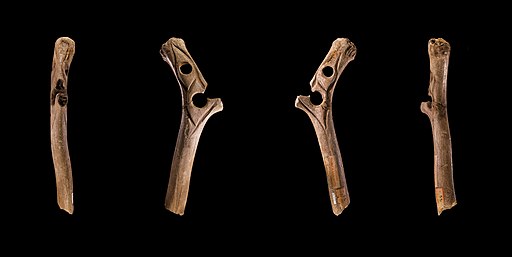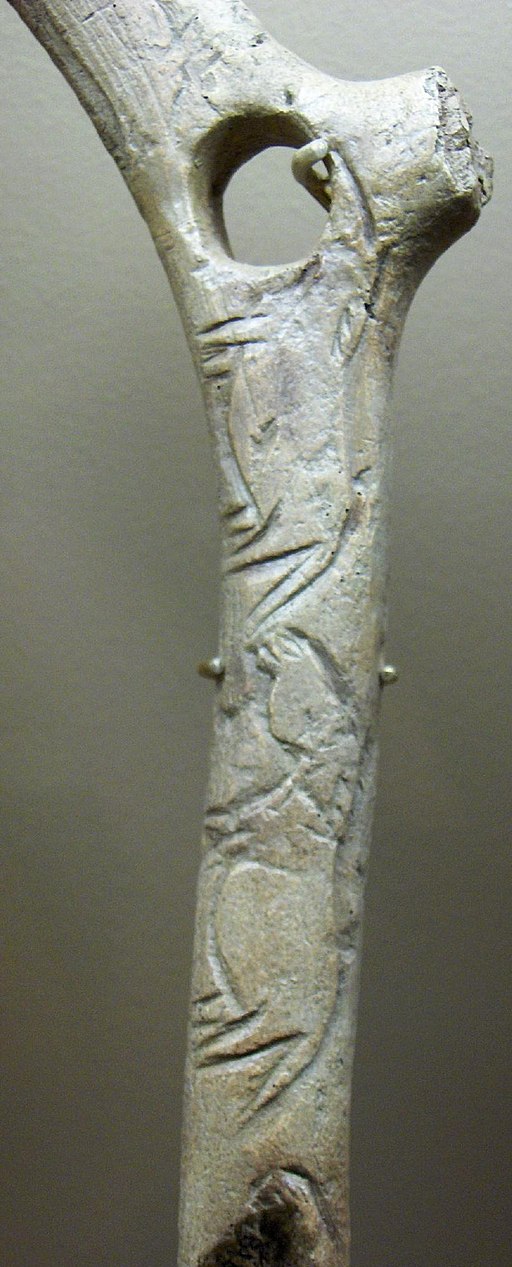
This “Perforated Baton” with low relief horse, was created during the last Ice Age (Upper Palaeolithic). This antler baton was used in the manufacture and throwing of spears.
The hole is a gauge to shape the shaft of the spear and rub the wood smooth. It was also used to straighten both the tips and the shafts. The baton is 16.6 cm long, 5.5 cm wide, and 3 cm thick.
By looping a strip of rawhide through the hole, the tool also becomes a weapon. Looping the thong around the end of the spear turns the baton into a spear thrower.
This object represents both a decorated tool and a weapon. It is an essential tool and piece of art that serves more than one function and is easily transportable when one is on the move.
The baton has one perforated hole in the near center, with a deep groove above it, which runs long ways just below the upper edge.
To the left of the hole is an image of a horse that appears in low-relief. The figure has a large eye, a high angular shaped mane, and small forelegs that seem to sweep backward. There are two incised V shapes on its flank that might suggest injury or movement.
This decorated fragment was discovered in 1863 at Abri de la Madeleine. The archaeological site Abri de la Madeleine (Magdalene Shelter) is a rock shelter under an overhanging cliff situated near Tursac, in South-Western France.

Four views of another Baton from Abri de la Madeleine
The Magdalene Shelter is the type-site for the Magdalenian culture. The occurrence of a large eye is a feature found on other baton examples excavated at La Madeleine.
Abri de la Madeleine
The Perforated Baton was discovered at the archaeological site Abri de la Madeleine represents the type site of the Magdalenian culture of the Upper Paleolithic.
The shelter was also occupied during the Middle Ages. The medieval castle of Petit Marsac stands on the top of the cliff just above the shelter.
The first systematic excavators of the site occurred in the 1860s, and the findings published in 1875 under the name of the “Age of the Reindeer.”
The significant objects that were found at the la Madeleine site are distributed among several museums, including the British Museum.
Magdalenian
The Perforated Baton was part of the Magdalenian cultures, which are cultures of the Upper Paleolithic and Mesolithic in western Europe. They date from around 17,000 to 12,000 years ago.
It is named after the type site of La Madeleine, a rock shelter located in the Vézère valley, the commune of Tursac, in France.
The Magdalenian epoch is associated with reindeer hunters. However, Magdalenian sites contain extensive evidence for the hunting of red deer, horses, and other large mammals present in Europe toward the end of the last ice age.
The culture was geographically widespread, and later Magdalenian sites stretched from Portugal in the west to Poland in the east.
Upper Paleolithic
The Upper Paleolithic or Late Stone Age dates to between 50,000 and 10,000 years ago, marked by the appearance of behavioral modernity in early modern humans.
This period includes the process of expansion of modern humans from Africa throughout Asia and Eurasia, which contributed to the extinction of the Neanderthals.
The Upper Paleolithic has the earliest known evidence of organized settlements in the form of campsites, some with storage pits.
Artistic work blossomed, with cave painting, petroglyphs, carvings, and engravings on bone or ivory.
Perforated Baton Functions
Perforated Batons are made from a length of antler with a round hole made in one end, and often have abstract, or animal designs etched into them. They have been found at sites of the Upper Paleolithic in Europe, with examples dating from 23–12,000 years ago.
There is a circular hole drilled through the antler just below the joint, and often a smaller second hole on the shaft.
Its purpose was initially thought to be as a symbol of power or status, hence the first name “bâton de commandement,” or “rod of command.”
Today’s interpretations for the uses of the Perforated Baton include:
- An arrow or spear-straightener, with the shaft to be straightened passing through the hole
- A spear-thrower
- A tool for smoothing and shaping leather thongs
- A symbol of fertility, with the male and female symbols, plus other more exotic interpretations.
Antler Perforated Baton – Paleolithic Portable Art
- Title: Antler Perforated Baton – Paleolithic Portable Art
- Created: 40,000 years old
- Period: Magdalenian Culture
- Discovered: 1863 – Abri de la Madeleine
- Materials: Antler
- Dimensions: Length: 16.6 cm; Width: 5.5 cm; Thickness: 3 cm
- Category: Ancient Artifacts
- Museum: The British Museum
Baton De Commandement: two 30 plus yard throws at target
Baton percé – Perforated Baton
A Virtual Tour of Important Historical Artifacts
- Prehistoric Stone Hand Axe – 2.6 Million Years Ago
- Perforated Baton with low relief Horse – 40,000 Years Ago
- Venus of Brassempouy – 25,000 years ago
- Wolverine Pendant of Les Eyzies – 12,500 Years Ago
- Ain Sakhri Lovers – 11,000 Years Ago
- Prehistoric Deer Skull Headdress – 11,000 Years Ago
- Narmer Palette – 3,100 BC
- The Stargazer (Statuette of a Woman) – 3000 BC
- Neolithic Painted Pottery – 2,500 BC
- Dancing Girl (Mohenjo-Daro) – 2,500 BC
- Li – Chinese Tripod Jar – 2,300 BC
- Treasure from Troy – 2,200 BC
- Bronze Age Gold Lunula – 2,200 BC
- Gudea, Prince of Lagash – 2,120 BC
- Law Code of Hammurabi – 1,750 BC
- Nebra Sky Disk – 1600 BC
- Mask of Agamemnon – 1,500 BC
- The Sphinx of Hatshepsut – 1,470 BC
- Tutankhamun’s Mask – 1,323 BC
- Mummy of Katebet – 1,300 BC
- Book of the Dead – Papyrus of Ani and Hunefe – 1,250 BC
- Avanton Gold Cone – 1,250 BC
- Bronze Age Shield Yetholm-type -1,200 BC
- Relief of a Winged Genie – 880 BC
- Siloam Inscription – 700 BC
- The Lion Hunt – 640 BC
- Ishtar Gate – 575 BC
- The Curse of the Tabnit Sarcophagus – 500 BC
- Kleroterion – 470 BC
- The Parthenon Marbles – 440 BC
- The Alexander Sarcophagus – 300 BC
- The Winged Victory of Samothrace – 200 BC
- The Rosetta Stone – 196 BC
- The Pergamon Altar – 150 BC
- Antikythera Mechanism – 100 BC
- Battersea Shield – 50 BC
- The Temple of Dendur – 10 A.D.
- James Ossuary – 1st-century
- Lindow Man – 2 BC and 119 AD
~~~
“The Stone Age did not end because we ran out of stones;
we transitioned to better solutions.”
– Steven Chu
~~~
Photo Credit: 1)Johnbod / CC BY-SA (CreativeCommons) from Wikimedia Commons; Didier Descouens / CC BY-SA CreativeCommons.
Popular this Week








 Sponsor your Favorite Page
Sponsor your Favorite Page SEARCH Search for: Search Follow UsJoin – The JOM Membership Program
Sponsor a Masterpiece with YOUR NAME CHOICE for $5
Share this:
- Tweet

